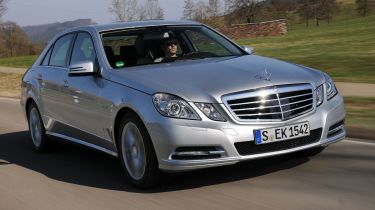Mercedes E300 BlueTEC Hybrid
Mercedes E-Class Hybrid is the most efficient car in its class, with fuel economy of 67.3mpg

The Mercedes E300 Hybrid is as efficient as a Ford Fiesta or a Fiat 500 diesel, which on its own is worthy of praise. Get behind the wheel though and you'll find there's even more to like about this E-Class, as it drives almost as well as a standard model. We had gripes with the brakes and jerky low-speed manouvres but in every other way this feels just like the impressive E-Class we know so well. With a £40,000 price-tag it certainly won't be a best-seller, but it could help Mercedes steal sales in the crucial fleet market thanks to its low CO2 emissions.
The new Mercedes E300 BlueTEC Hybrid is the most efficient large executive car on the market, and it's also the first to come with a diesel-electric powertrain. But in one of the most competitive segments, cars have to boast more than high economy figures.
This car is essentially a mix of an E250 CDI and an electric motor. That means it gets a 201bhp 2.1-litre four-cylinder diesel engine boosted by a 20kW motor. Together they help this car sprint from 0-62mph in 7.5 seconds and achieve 67.3mpg. By comparison, the standard Mercedes E250 CDI is 0.2 seconds slower to 62mph and can only manage 53.3mpg.
Used - available now

2020 Mercedes
E Class
16,426 milesAutomaticDiesel2.0L
Cash £30,587
2022 Mercedes
E Class
35,714 milesAutomaticDiesel2.0L
Cash £26,000
2022 Mercedes
E Class
44,201 milesAutomaticPetrol2.0L
Cash £25,900
2022 Mercedes
E Class
46,558 milesAutomaticPetrol2.0L
Cash £26,763Crucially, the Hybrid reduces CO2 emissions to a class-leading 109g/km which has money-saving implications for company car drivers. Previously the cleanest E-Class emitted 129g/km.
Those class-leading figures aren't just achieved through the addition of the electric motor, but have been boosted by extras like stop-start and a 'sailing' mode. The latter works at speeds of up to 100mph and keeps the car at a steady speed using the electric motor alone. In the real world it's a seamless process that you'll barely even notice.
Aside from a few hybrid badges on the boot and on the centre console, this looks like any other E-Class and it drives much like one too. Refinement is boosted even further by the silent low-speed manoeuvring and the extra 100kgs of weight added by the hybrid system hasn't had an impact on the excellent ride quality.
The E-Class doesn't pretend to be a driver's car and you shouldn't expect anything different from the Hybrid. The quick steering is responsive and there's enough grip to give you confidence in the corners, but the soft suspension and lack of feedback aren't exactly a recipe for fun.
Drivers swapping out of a standard E-Class will notice a few differences in the driving experience though. Either it's the additional weight, the regenerative braking system or a combination of the two, but the brakes feel as though they need a firmer push than usual to bring you to a halt. Three-point turns have become a slightly jerkier affair too, as the computers shuffle power around between the electric motor and the engine.
Unlike other hybrid models – like the Citroen DS4 and Peugeot 3008 – the Mercedes set-up doesn't intrude into the cabin or the boot, ensuring the E-Class is as practical as ever. In estate form that means it's not only the most efficient car in its class, but it still boasts the largest boot space, too.
Mercedes hasn't yet announced full pricing details for the new E300 Hybrid but did say that it would cost 51,794 Euros in Germany - this should translate to a price of around £40,000 in the UK. That makes it far more expensive than any other eco-option in this class, but Mercedes is also promising a very generous list of standard equipment.






